Updated 7 months ago
The Best Solar Panels in 2025: Expert Guide
Written by
Ben Zientara
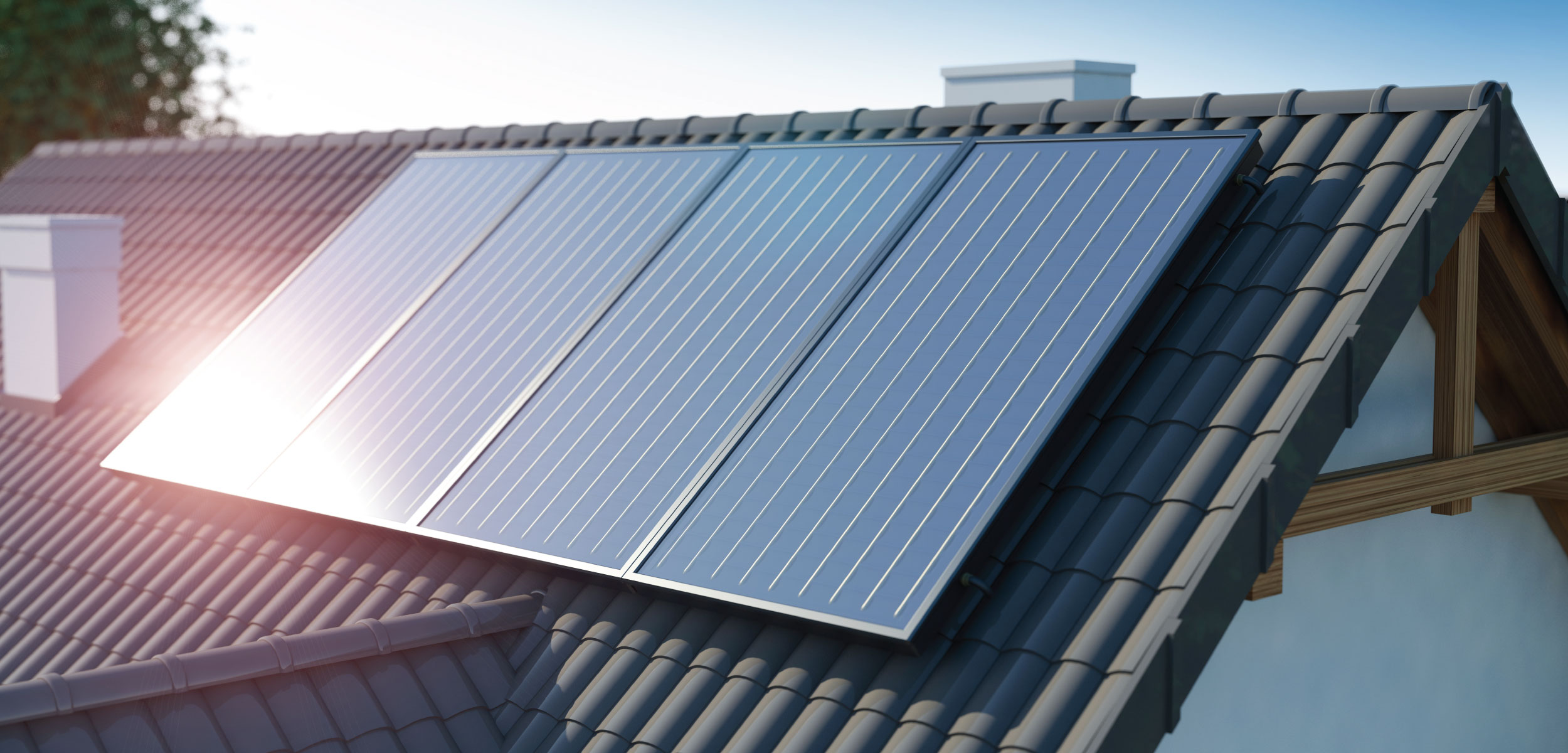
Calculate how much the best solar panels will cost for your home
Choosing the best solar panels for your needs can be a complicated decision. You have to consider multiple factors, like price, performance, aesthetics, and warranty coverage—and don’t forget, a warranty is only as good as the company that stands behind it.
Luckily, our solar experts have considered all of these factors and come up with a holistic ranking system that takes all the important factors into consideration.
The list below shows the 10 best solar panels according to our solar experts:
Rank | Company | SolarReviews rating | Best residential solar panel |
|---|---|---|---|
1 | Canadian Solar | Elite | TOPHiKu6 All-Black |
2 | JA Solar | Elite | DeepBlue 4.0 |
3 | Qcells | Elite | Q.TRON AC |
4 | Silfab | Excellent | Prime NTC |
5 | Jinko Solar | Excellent | Eagle 54 |
6 | Panasonic | Excellent | EverVolt HK2 Black |
7 | REC | Excellent | REC Alpha Pure-RX |
8 | Trina Solar | Excellent | Vertex S+ |
9 | SEG Solar | Excellent | Yukon N |
10 | LONGi | Excellent | HiMo5 |
Bottom line on the best solar panels
If you’re considering solar power for your home, you can’t go wrong with any of the companies on our Top 10 list. All of them fall into the Elite or Excellent categories, and the differences between them in points scored is generally quite small, with just eight points separating 1st place from 10th.
Ultimately, the best solar panels for your specific needs depend on the things you feel are most important. Here’s a quick rundown of our expert advice:
If you want to follow our recommendation for a great solar panel from a successful company with a good warranty: choose Canadian Solar
If you want the most popular brand in America: choose Qcells
If you want the best warranty from a company that will be around to back it up: choose Panasonic
If you value performance above everything, aren’t concerned about company financials, and money is no object: choose Maxeon
Or, you can compare multiple quotes from solar installers near you and cross-reference those quotes with our list here to check if they’re recommending any of our Top 10 brands of solar panels in the USA!
Pros and cons of the best solar panel brands
We highly recommend products from any of the brands on our list, and all of the Top 10 brands listed above were ranked Excellent or higher by our solar experts.
Unlike other websites, SolarReviews looks beyond just performance specifications, including things like company financials and industry opinion to give homeowners an idea of what brands they can truly trust.
Let’s take a look at each of the brands:
#1 Canadian Solar
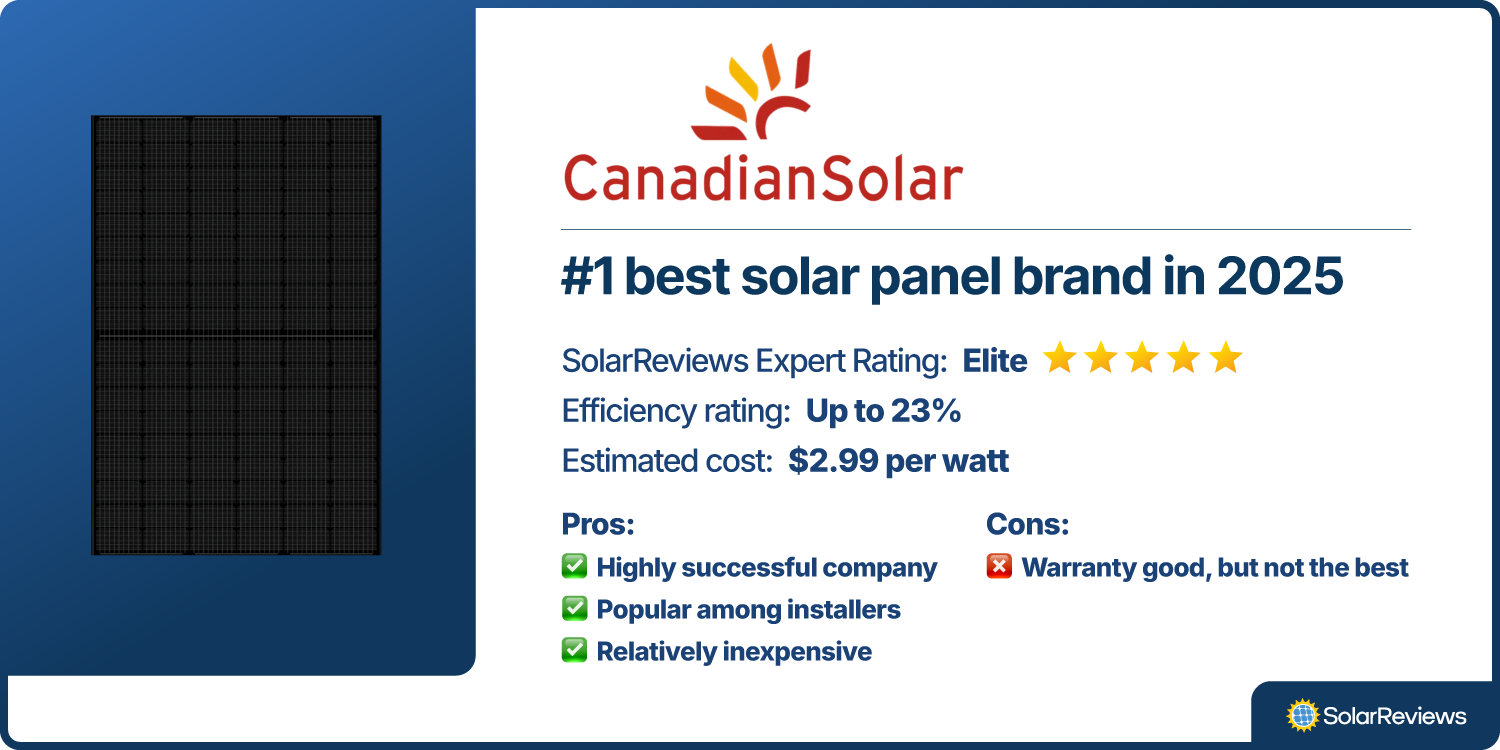
Canadian Solar is our #1 pick for 2025. The company has been manufacturing solar panels since 2001, making it one of the oldest brands on our list. Canadian Solar’s products are known for their reliability and affordability and are used by solar installers nationwide.
#2 JA Solar
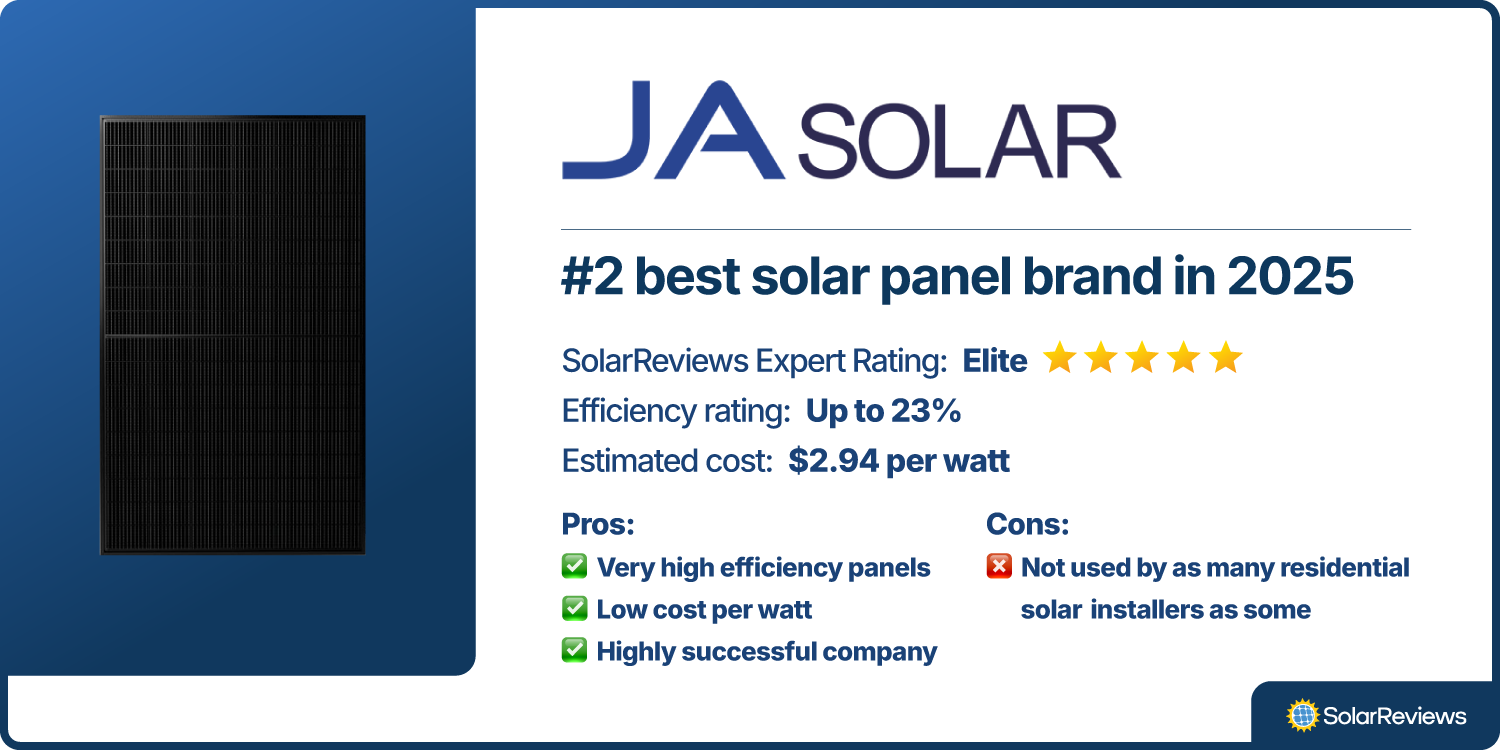
JA Solar takes the #2 spot in our rankings this year on the strength of its financial performance, high-performance panels, and low prices.
#3 Qcells
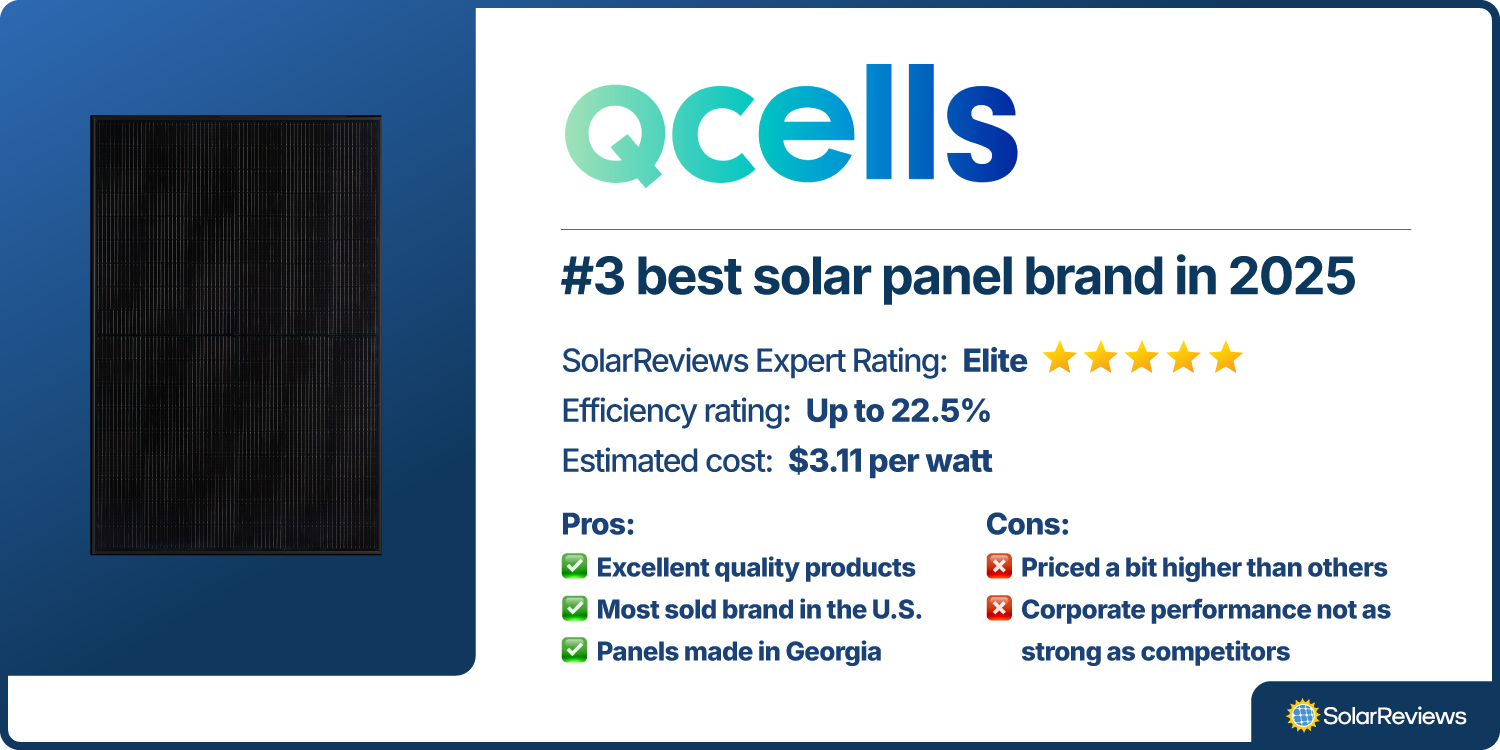
Qcells is the most popular brand in residential solar thanks to quality equipment and pricing. SolarReviews statistics show that 58% of solar installers offered Qcells panels in the past year, but changes in the competitive landscape kept it at the 3rd place spot on our list.
#4 Silfab Solar

Our 4th place choice, Silfab Solar, is a privately-owned company with headquarters in Canada and U.S. manufacturing facilities in Washington state. Silfab is another company with a long history of manufacturing in the United States, and its panels are beloved by installers across the country.
#5 Jinko Solar
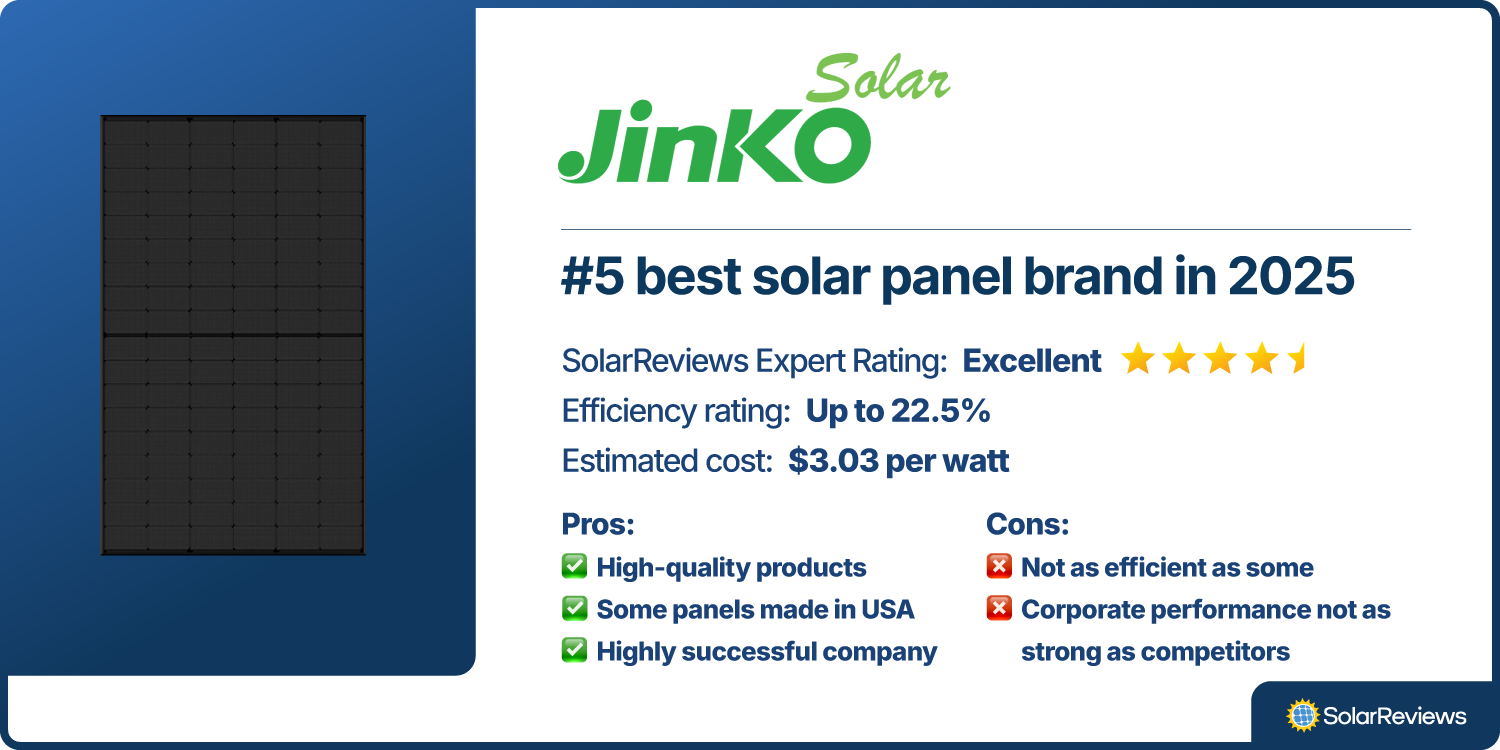
In 5th place is Jinko Solar, one of the biggest solar manufacturers in the world. Jinko Solar is best known for its low prices and dependable solar panels.
#6 Panasonic
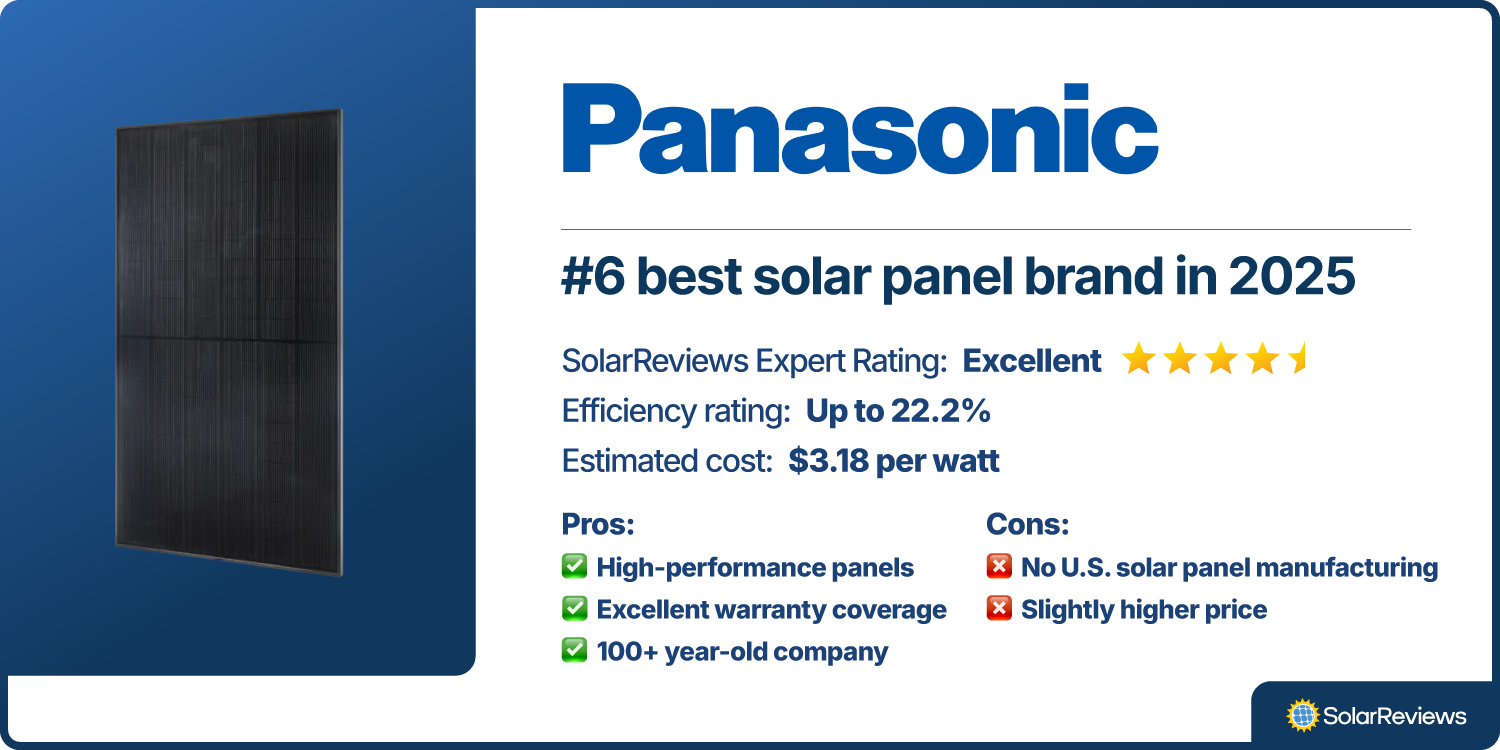
Global electronics brand Panasonic takes 6th place in our list this year on the strength of its ecosystem and longstanding success in business. With such a long and storied history, you can be sure Panasonic will be around to honor its excellent warranties.
Note: On April 28, 2025, Panasonic North America announced it would discontinue its solar and battery storage offerings. The company has said it is committed to long-term warranty support for existing customers as well as customers with installations in progress. While we still the utmost have confidence in Panasonic's warranty coverage, people who have not yet signed a contract should consider the other brands on our list as an alternative.
#7 REC
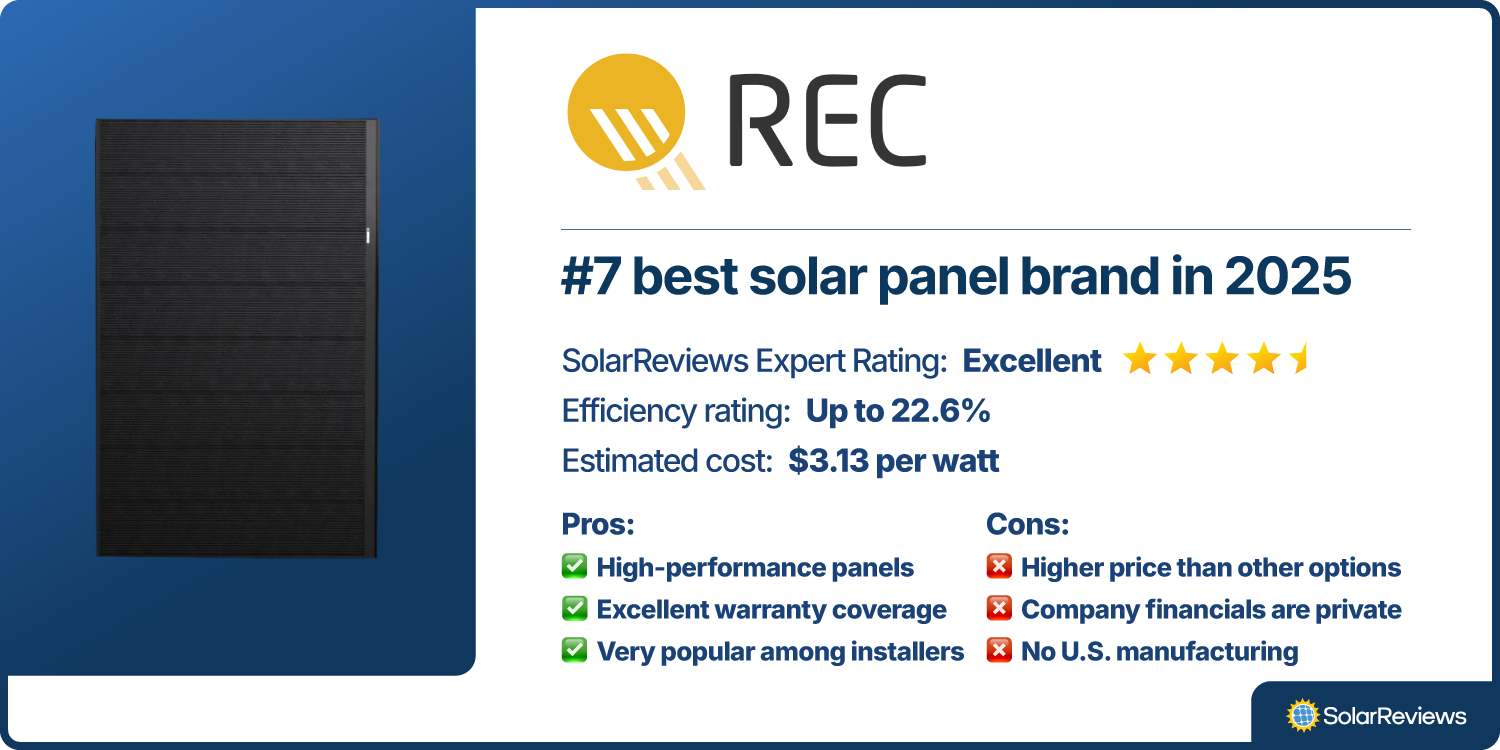
REC earns 7th place in our rankings on the strength of its market share, high-performance panels, and excellent warranty. Despite those things, the company doesn’t rank higher on our list because its financial reporting is not public and it hasn’t announced any U.S. manufacturing. Nevertheless, REC solar panels are extremely high quality, and we recommend them highly.
#8 Trina Solar
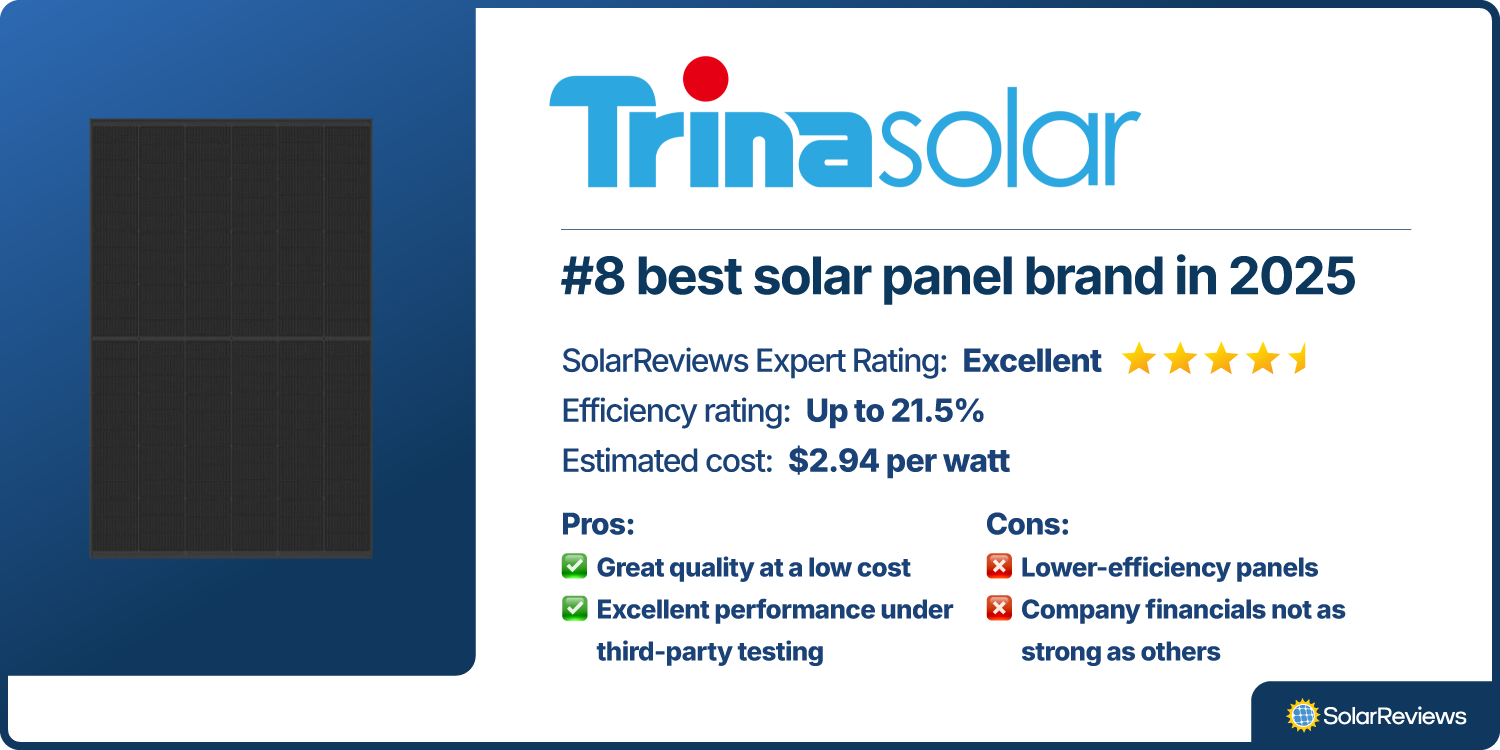
In 8th place, we have Trina Solar, a huge Chinese organization known more for its utility-scale solar panels than residential products. That said, the company’s panels are affordable and well-made and still come with 25-year product and performance warranties.
#9 SEG Solar
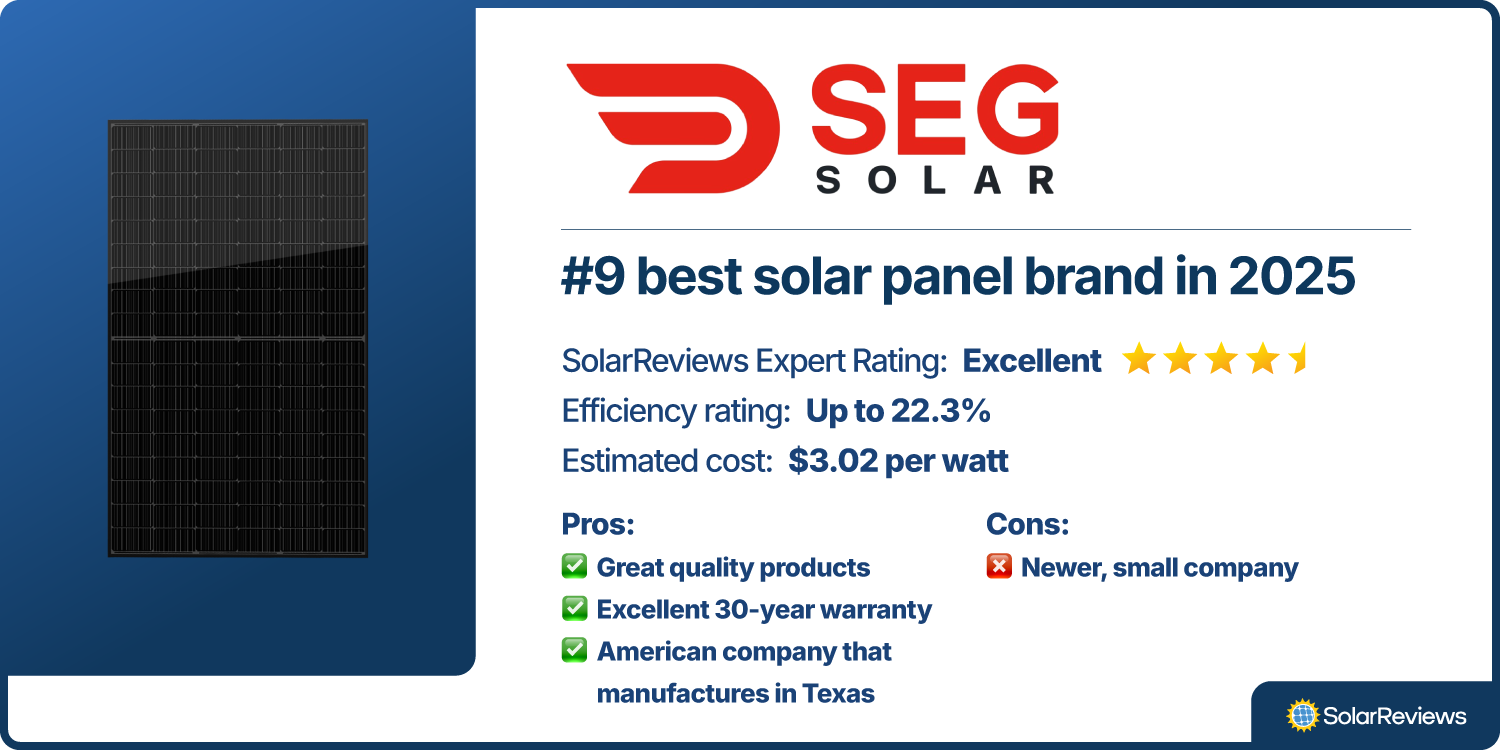
USA-based SEG Solar moves up one spot this year into 9th place. The company opened its Houston, TX manufacturing plant in 2024 and now has the capacity to produce one gigawatt of panels per year.
#10 LONGi
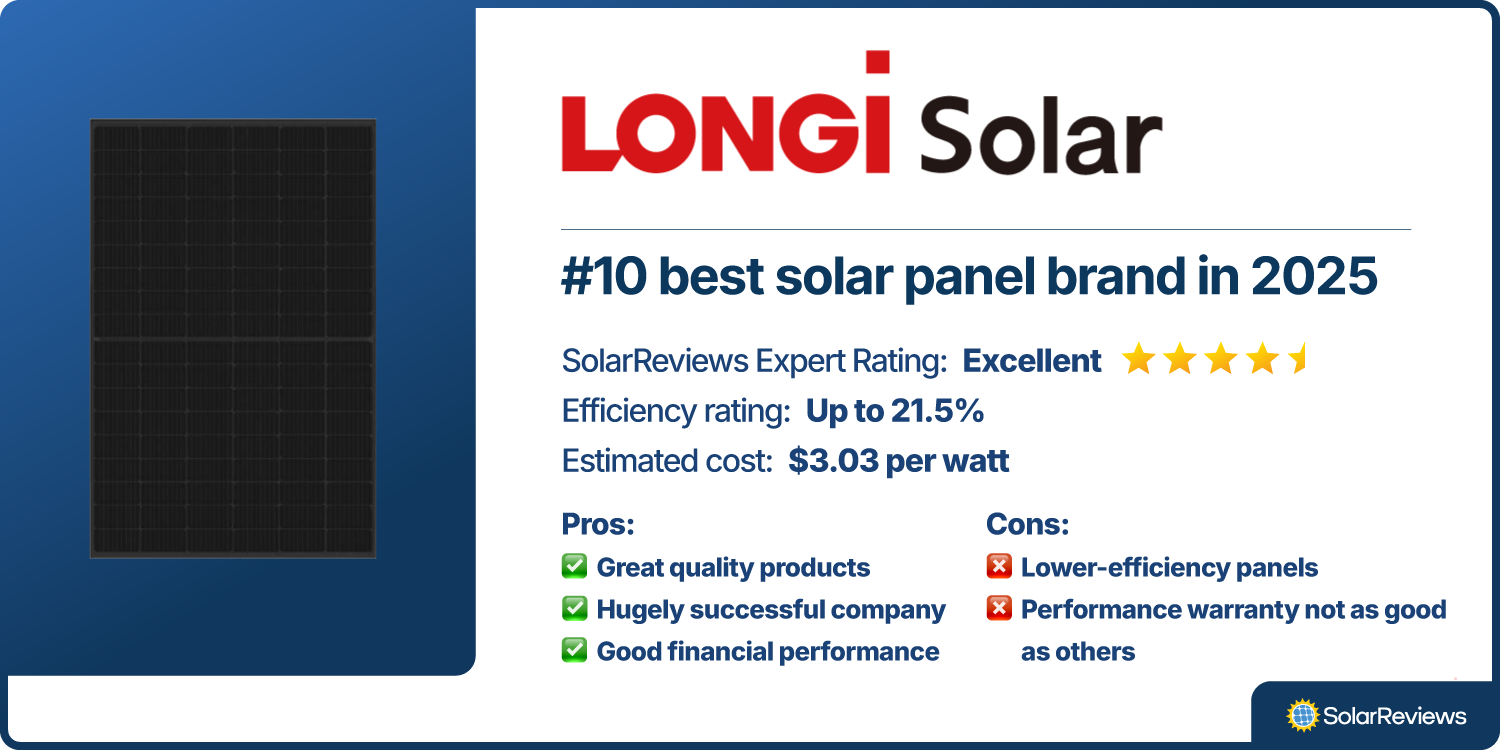
The final company on our Top 10 list is LONGi, another huge Chinese company that is well diversified and measures revenue in the tens of billions of dollars. In North America, the company is still offering its reliable HiMo5 line of solar panels, which are a great value for homeowners.
What factors determine the best solar panels?
The factors that determine the performance of solar panels include:
Efficiency, or how much of the sun’s energy is converted to electricity
Temperature coefficient, which refers to a loss of power production due to increases in operating temperature
Performance in harsh conditions measures durability in hot, humid environments, high winds, and hail
Degradation rate, which is the amount of power output capability a panel loses each year, is about 0.4% per year on average
In addition, there are several other factors that could influence your decision of which panel to choose:
Price, based on dollars per watt of power-generating capability
Warranty protection, with coverage for product workmanship and power production over the panel’s lifespan
Company financial performance, because a warranty is only as good as the company that stands behind it
Commitment to U.S. manufacturing, because domestic products can qualify for better solar incentives and have a lower carbon footprint
Popularity with installers, because the best companies make solar panels that professionals trust
SolarReviews brand ranking methodology
When it comes to ranking solar panels, SolarReviews does things a bit differently than most. We don’t just look at efficiency and popularity, but instead take a holistic approach that considers all of the factors listed above.
We believe that the best solar panels come from companies with a proven track record of success, who produce high-quality products at fair prices.
Our ranking methodology awards 50 points to companies across the evaluation criteria, using the following measurements:
Category | What we look at |
|---|---|
Solar panel performance (10 points) | Efficiency, temperature coefficient, listing on Kiwa PVEL Top Performer scorecards for the past 5 years |
Warranty (5 points) | Product and performance warranty coverages, solar panel degradation percentage |
Company financial performance (10 points) | Public financial statements, total revenue, revenue growth year-over-year, net income |
Investment in the U.S. (7.5 points) | HQ or office locations in the U.S., domestic materials sourcing, domestic manufacturing capability, regular attendance at trade shows |
Value (12.5 points) | Average wholesale cost per watt DC in container volumes for the U.S. market. |
Dealer network and market share (5 points) | Average market share from public solar installation databases, along with installer opinions of the brands from our annual solar industry survey statistics |
Overall score (50 points) | ≥ 39 - Elite ≥ 34 - Excellent ≥ 29 - Very Good ≥ 24 - Good ≥ 19 - Average Under 19 - Unrated |
Compare the best solar panels of 2025
All of the solar panels on our list have an Excellent or higher rating from SolarReviews’ experts, so any of them would make a great addition to your home. But, there may be one that better suits your specific needs. The following table gives you a quick glance at how our top ten panel brands stack up:
Brand | Estimated cost per watt* | Highest power output | Highest efficiency rating | Product warranty | Performance warranty** |
|---|---|---|---|---|---|
Industry average | $3.04 | 440 W | 22% | 25 year | 25 years, 0.4% annual degradation rate |
Canadian Solar | $2.99 | 470 W | 23% | 25 years | 30 years, 0.4% annual degradation rate |
JA Solar | $2.94 | 460 W | 23% | 12 years | 25 years, 0.4% annual degradation rate |
Qcells | $3.11 | 440 W | 22.5% | 25 years | 25 years, 0.33% annual degradation rate |
Silfab Solar | $3.05 | 430 W | 22.1% | 25 years | 30 years, 0.30% annual degradation rate |
Jinko Solar | $3.03 | 440 W | 22.5% | 25 years | 30 years, 0.40% annual degradation rate |
Panasonic | $3.18 | 430 W | 22.2% | 25 years | 25 years, 0.25% annual degradation rate |
REC Group | $3.13 | 470 W | 22.6% | 25 years | 25 years, 0.25% annual degradation rate |
Trina | $2.94 | 430 W | 21.5% | 25 years | 25 years, 0.4% annual degradation rate |
SEG Solar | $3.02 | 435 W | 22.3% | 30 years | 25 years, 0.4% annual degradation rate |
LONGi | $3.03 | 425 W | 21.5% | 25 years | 25 years, 0.55% annual degradation rate |
*Price estimates calculated before tax credits and other solar incentives, based on 2024 cost data from the National Renewable Energy Laboratory, Bureau of Labor Statistics, and online solar pv distributors. Actual price will vary between installation companies.
**Lowest degradation rate offered by the company. Actual degradation rate and warranty terms vary by model.
Why are some brands missing?
If you’re familiar with the photovoltaic solar industry, you may notice that there are some big names left off of our list. Companies like Maxeon, Meyer Burger, and Mission Solar are not on our top 10 list for 2025. These companies all make fine products but did not excel in one or more of our criteria for this year, ranking them lower than 10th place on our list.
Maxeon, in particular, makes some of the highest quality, most efficient solar panels in the world, and their products are backed by a tremendous 40-year warranty, but the company has fallen on some hard times in the past year, ending its relationship with their former partner and largest customer, SunPower (which declared bankruptcy shortly thereafter), having their solar panels seized by border patrol agents, and seeing massive reductions in revenue.
We’re rooting for Maxeon to succeed, because its solar panels are truly a cut above the rest when it comes to quality and performance, but until the company overcomes their recent financial and logistical struggles, they won’t make our list.
Why choosing the right installer matters more than choosing the best solar panel
When it comes down to it, many companies today are producing extremely high-quality solar panels that will reliably make energy for decades to come.
What truly matters is choosing the right solar installer. The company you choose is the key player in your solar journey—they'll be on your roof, drilling through shingles, running wires, and the ones you'll turn to if issues arise. Selecting a company that will be around to support you is crucial.
We recommend opting for a local solar company with at least five years of experience, its own crews, and a track record of consistently positive customer reviews. Local installers typically possess a deep understanding of solar in your area, offer fair prices, and provide top-notch customer service.
The trust you place in your installer extends to the equipment they carry. Reputable installers are likely to offer high-quality equipment. If you’ve picked the right installer, you should feel confident in what they’re installing on your roof.
Get and compare solar quotes from multiple installers to get the best deal on a solar installation!
See all of our lists
Ben Zientara is a writer, researcher, and solar policy analyst who has written about the residential solar industry, the electric grid, and state utility policy since 2013. His early work included leading the team that produced the annual State Solar Power Rankings Report for the Solar Power Rocks website from 2015 to 2020. The rankings were utilized and referenced by a diverse mix of policymakers, advocacy groups, and media including The Center...
Learn more about Ben Zientara